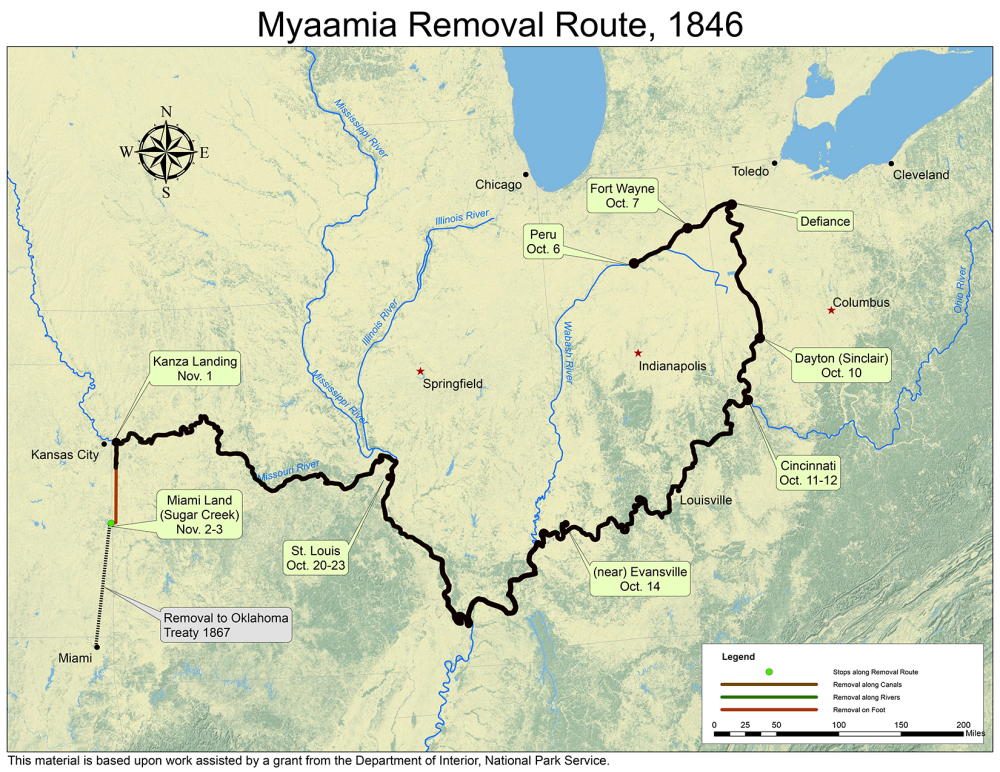November 2,1846 Beginning the Overland Journey
Both Toohpia ‘Francis LaFontaine’ and Removal Agent Joseph Sinclair wrote that this morning Myaamiaki left the Town of Kansas, present-day Kansas City, Missouri, for the new Miami Reservation in what is today eastern Kansas. Even before leaving the Town of Kansas, Toohpia also wrote, “This far the country does not please me.” Coming from a land that was 80% forest to a place that was 80% plains, it is not surprising that Toohpia was not pleased with the land he saw before him. We can imagine that few, if any, Myaamiaki were pleased with this strange place.
In the October 7 blog post, we saw that the day after Myaamiaki left Iihkipihsinonki ‘Peru, Indiana’ on the canal boats, Joseph Comparet and his hired men left Iihkipihsinonki with the Myaamiaki’s horses. They “arrived at the mouth of the Kanzas river in the State of Missouri” on November 1. Comparet’s report to Sinclair repeatedly emphasized that “the ponies were properly fed and cared for.” He went on to say that “every attention in our power was paid to the proper feeding and care of the ponies under our charge, and the means furnished by the contractors for that purpose were ample, no one of the ponies was allowed to suffer for the want of proper care and feeding.” Then we see why Comparet was so emphatic on the point of taking good care of the horses, as he confessed,
“The trip was a long one, and seven of the ponies, which were old and very poor when they started gave out, and four of that number died; one we sold for one dollar; and another for five dollars; and another for two dollars, they were unable to travel and it was thought to be advisable by a sale to save something for the owners. I have rendered an account of these sales to the Indians and are directed to pay over the proceeds of the sales to the proper persons. Two of the ponies were stolen near Fairview, Illinois, from our encampment during the night. The residue ninety in number delivered over to the Indians as aforesaid.”
We have no reports to verify or deny Comparet’s statement about the condition of the seven horses, but we can be sure that the Myaamia owners of those horses knew the truth of the matter. The small amount that Comparet claimed to receive for the sale of three of the horses was most probably shocking to the Myaamia owners. In an 1854 claim for the 120 horses Myaamiaki had to leave behind in Indiana at Removal, the value of the horses ranged from $30 to $250 per horse, an average value of $39 per horse. Myaamiaki knew the value of their horses. They must have known that Comparet was cheating them out of the value of at least the three horses they admitted selling.

The ninety horses that made the entire journey arrived the same day as the Clermont No. 2, on November 1. Traveling overland took one day less than traveling by boat. Toohpia had been right when he said Myaamiaki should have been taken by land, rather than by boat. If they had, they might have avoided the illness that had plagued them throughout the journey. In any case, their horses arrived just in time to help them on the journey south to the Miami Reservation. “A portion of [Myaamiaki] rode their poneys, and the residue with the baggage was brought through by the contractors in waggons.” By “the residue,” Sinclair was rudely referring to the Myaamiaki who were not riding horses.
In the next installment, to be posted on November 3, we will follow Myaamiaki as they continue on this journey.
Post written by Diane Hunter, Tribal Historic Preservation Officer for the Miami Tribe of Oklahoma. Diane can be contacted at dhunter@miamination.com.